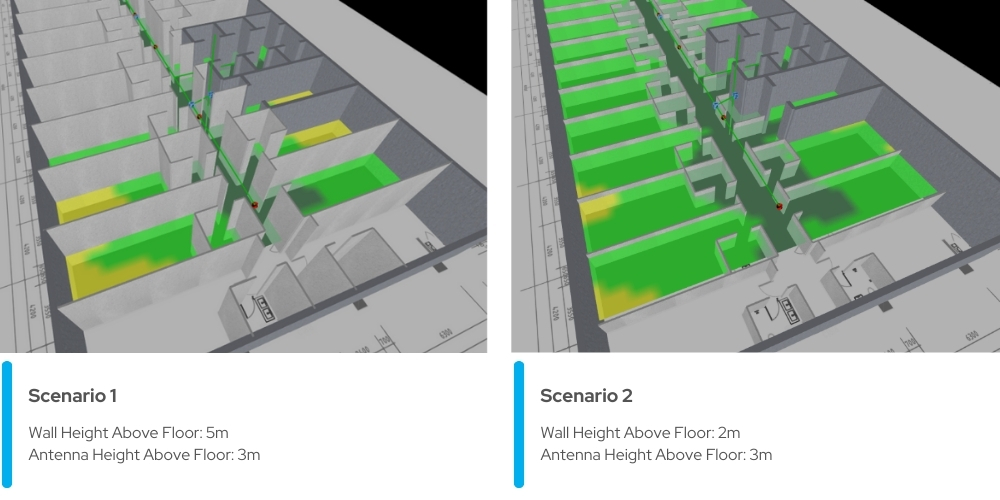Mastering In-Building DAS: Avoiding Common Design Mistakes
With the growing demand for wireless communication, in-building Distributed Antenna Systems (DAS) have become essential for ensuring reliable signal coverage. RF design and planning are vital for ensuring reliable wireless communication in indoor environments, particularly in large buildings. This process involves assigning frequencies, selecting transmitter locations, and defining key parameters to achieve sufficient coverage and capacity for maintaining calls and data sessions. However, even minor mistakes or misinformation can lead to significant design revisions, costing valuable time and resources.
Why are these small details so crucial? In this article, we’ll explore some common mistakes in indoor RF planning and design.
1. Frequency Mismatch in RF Components
RF components are typically designed to operate within specific frequency ranges to ensure optimal performance and signal integrity. Using a component outside its intended frequency range can result in degraded performance or even complete signal loss. Always ensure RF components are correctly matched to the system’s frequency requirements to avoid issues that could disrupt functionality.
2. Overlooking Power Handling Capacities of RF Components
Continuous operation of RF systems, particularly over prolonged periods, can cause components to overheat, leading to instability or performance degradation. Choosing components with power ratings that can handle the system’s power levels is crucial, particularly for those positioned close to the RF power source. Proper power management ensures the longevity and reliability of the system.
3. Incorrect Wall and Prediction Height Settings
a) Wall Height
In indoor environments, walls and partitions can obstruct signal propagation. Modern RF design often uses simulation software to predict coverage, making accurate parameter settings critical. For example, wall heights must be correctly inputted to avoid inaccurate signal predictions. The comparison of two scenarios below shows how different wall heights can affect signal propagation.

b) Prediction Height Settings
Prediction height typically simulates the height of handheld devices, often set at 1.2m or 1.5m. However, in specialized networks—such as those involving IoT devices—the devices may be mounted at various heights. In these cases, it is crucial to run simulations at multiple heights to ensure accurate coverage predictions. For instance, in a warehouse environment, running simulations at 6m and 2m will provide a clearer understanding of signal consistency at different heights.
4. Mishandling Sectorization in Vertical Voids
Designing RF systems for multi-level buildings with vertical voids requires careful attention. Signal spillover from higher to lower floors can cause interference if not properly managed. It is advisable to assign a single sector to cover the vertical void. If this isn’t possible, limit the overlap to no more than three sectors at handover borders to reduce interference and optimize coverage.
5. Neglecting Scalability Considerations
DAS (Distributed Antenna System) designs should consider future expansion. In high-traffic venues like event halls, sports arenas, shopping centers, etc, designing for future sectorization is essential. By planning for sector splits in advance, the system can be easily expanded with minimal adjustments, saving time and avoiding the need for extensive rewiring.
6. Poor Handover Demarcation in Crowded Areas
In venues with high traffic of people , careful planning of handover points is essential. Positioning handover demarcations in areas with dense static crowds can lead to constant handovers, resulting in poor user experiences. Instead, place these points in less congested areas to enhance network stability and reduce the likelihood of “ping pong” handover issues.
7. Placing RF Components in Inaccessible Areas
In-building design engineers and network operation teams often work separately, leading to designs that overlook practical maintenance concerns. To ease future maintenance, place RF components like splitters and cables in accessible locations. While not always possible, striving for this in the design phase can significantly reduce long-term maintenance challenges.
8. Over-Sectorization of Elevators in High-Rise Buildings
Elevators in high-rise buildings present unique challenges for DAS design. Frequent handovers due to floor changes can increase the risk of call drops. To minimize this issue, design the system so that the same sector serves the entire elevator shaft, reducing handover events and improving call stability.
About Chin Vui Lee
Chin Vui LEE earned his degree in Communications and Computer Engineering from The National University of Malaysia in 2014. With nine years of dedicated experience in the telecommunications sector, he has honed his expertise in In-Building Solutions (IBS), Distributed Antenna Systems (DAS) design, and Radio Frequency (RF) planning. As a Senior Solutions Engineer at Comba, he is responsible for delivering cutting-edge designs and solutions for in-building systems, playing a critical role in advancing connectivity and enhancing communication infrastructure.